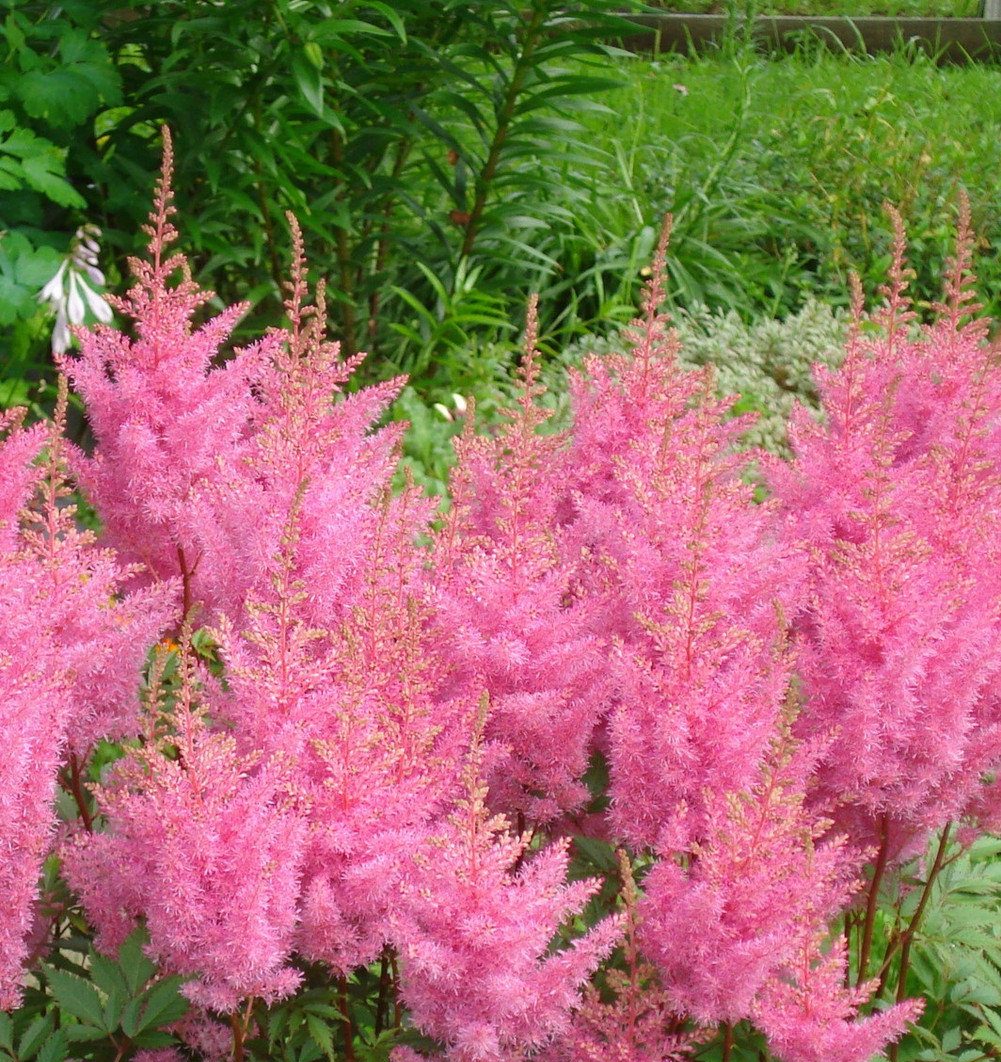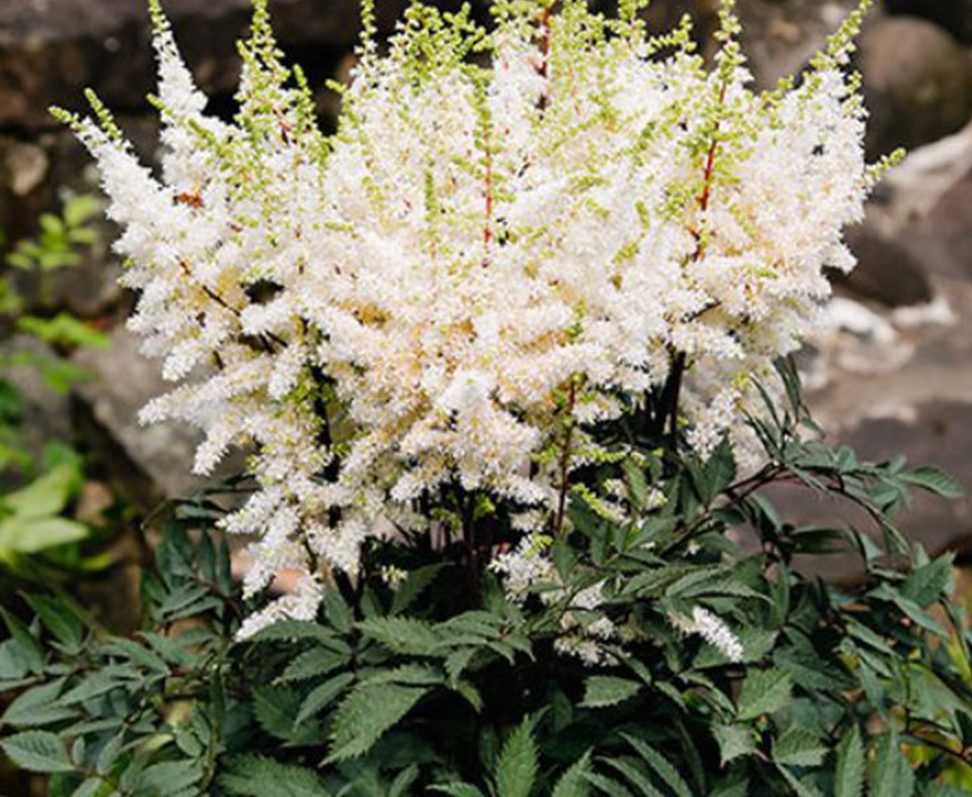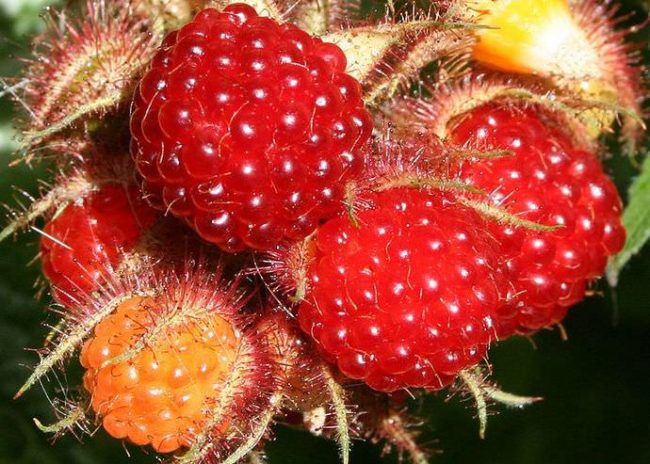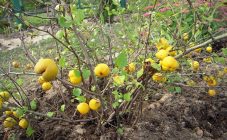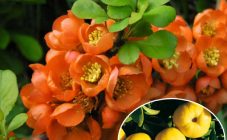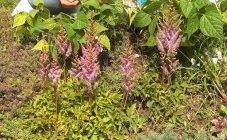Content:
The shade-preferring Japanese Astilbe is a dull creeping plant with matte petals. It is represented by several varieties that differ in appearance and flowering time. Astilbe can remain a decoration of the garden for 3-4 months in a row, covering very large areas with a solid mass of blooming.
Japanese astilba varieties: TOP-12
If we talk about Japanese astilbe in general, it should be noted that these are perennial herbaceous hybrids, characterized by high frost resistance. They are used for decorative purposes, and not only delicate flowers, but also the openwork foliage surrounding them become decoration.
Astilbe bushes can reach 0.5-0.8 m in height. Inflorescences in representatives of Japanese perennials have a rhombus shape with a length of 15-30 cm and have an increased density. Their colors can be either pale and expressionless, or very bright.
The leaves of Japanese astilbe are glossy and bipinnate with a pointed tip, and also often have serrated edges. They are attached to the stem by means of brownish petioles. The shade of the foliage, depending on the selected variety, can be either dark or light.
However, it is not the general external features of the hybrids that are of much greater interest, but the specific ones inherent only in certain varieties of Japanese astilba.
Washington
The height of the main bush in this culture is about 30-40 cm, and its peduncles are often twice as high. The foliage is colored light green and has a delicate outline. This makes it equal in decorative properties with white and airy diamonds of inflorescences, blooming in the first decade of July.
Vesuvius
Japanese astilbe varieties Vesuvius are relatively low (40-60 cm). Their carmine-red panicle inflorescences are also small - about 10-15 cm. Like many other varieties, Vesuvius's leaves are burgundy in spring, and then acquire a dark green tint. It blooms in July-August for 20-30 days.
Deutschland
The approximate height of the Deutschland astilbe is 0.6 m. Without taking into account the peduncles, this indicator decreases to 0.3 m. The bushes of this variety are spreading, but they also retain their compactness.
Inflorescences:
- white;
- medium density;
- 15-20 cm long.
The opening of the flowers of Astilba Japanese Deutschland occurs in early July. Withering occurs after 20 days and is preceded by the appearance of a cream-colored inflorescence in the color.
Dusseldorf
The maximum height of the Dusseldorf astilbe with peduncles barely reaches half a meter, and without them it is limited to 30 centimeters. The inflorescences of this perennial are large - 15 cm in length, painted in dark pink. The shade of the foliage is reminiscent of forest greenery.
Buds on Astilbe Dusseldorf begin to appear from June 5th. The flowering period usually occurs in July, but can sometimes last until the end of August.
Europe
Astilbe Japanese Europe (Astilbe Japonica Europa) is a sprawling shrub with a maximum peduncle length of 0.5 m. It is distinguished by bright tripartite fern-colored leaves. Inflorescences of "European" astilbe:
- pale pink (pure pastel shade);
- 15 cm long;
- are odorless;
- lush and thick.
The buds are set at the end of May, the main flowering period (20-25 days) is in July.In the case of the August pruning of Astilbe, Europe will retain its shape until the very frost. In general, the plant successfully adapts to stagnant moisture and excess sunlight, and also coexists well with tulips, peonies and Siberian irises.
Montgomery
This variety has impressive external data:
- inflorescences - blood red;
- stems are brown;
- foliage - brownish-burgundy in spring and dark green in summer.
In height, the erect peduncles of the Japanese astilba Montgomery reach about 65 cm. The bushes and inflorescences of this plant are dense and neat. The brush is 17 cm long and 10 cm wide.
Peach Blossom
Astilba Peach Blossom is a tall, early flowering variety. The height of the bushes can reach 0.7 m. In external characteristics, this culture is very similar to astilba Europe. However, Peach Blossom's inflorescences are paniculate, not rhombic.
In addition, its leaves have a reddish or reddish tint, unusual for Europe. Finally, the peach-pink tone of the inflorescences of Astilba Japanese Peach Blossom differs markedly from the pure pale pink "European".
Red Sentinel
Astilba Red Sentinel was not bred in Japan, but in Holland. Plants of this species have the following characteristics:
- bush height - 0.5 m;
- leaf color - reddish brown in spring and dull green in summer;
- the color of the leaf axis and peduncles is green with a reddish tint;
- the color of the leaf petioles is green;
- inflorescences are large (about 20 cm), dark red.
Such external data make this variety very similar to Montgomery. However, the Japanese astilba Red Sentinel is noticeably lower (by about 15 cm), and its bushes are more stocky. It can also be recognized by its larger inflorescences with characteristic bluish anthers and white-pink sepals.
Rhineland
The height of the middle layer of the Japanese Rhineland astilba with peduncles is 70 cm, without them - 30 cm. Its inflorescences are extremely large (up to 25 cm) panicles of a pyramidal shape and pinkish-carmine color. The foliage of the Rhineland is bronze-green, has a shine and has an openwork edging.
Chocolate Shogun
The Japanese Astilba Chocolate Shogun is perhaps the most famous. This variety was awarded a silver medal at the Dutch exhibition PLANTARIUM-2013. And this award was well deserved. The first thing that attracts the attention of Astilba Japanese Shogun Chocolate is its dark glossy leaves. They retain their maroon hue throughout the season. Thanks to this, the deciduous mass, reaching a height of 35 cm, contrasts beautifully with the creamy pink inflorescences of the Chokolat shogun astilba. The length of the peduncles in plants of this species is 0.6 m. The flowering period of the Japanese Chocolate Shogun astilbe falls on July-August.
Elizabeth Van Veen
Astilba Elizabeth Van Veen loves shady places: there she can grow up to 0.6 m in height. If she is in the sun, she will not be able to overcome even the bar of 0.4 m. The spring color of the fringed foliage of this hybrid is brown-red. Later it turns green, but the petioles and peduncles (of which this species has a huge number) remain brown.
The inflorescences of the Japanese astilba Elizabethvan Veen are colored with rich violet-lilac and violet-crimson shades. Opening of buds occurs on July 14-17, and wilting - in early August.
Ellie
According to the standard description, Ellie astilba should be considered the owner of the whitest inflorescences. In addition, when withering, the flowers of this plant, collected in dense panicles, turn not brown, but green.
The length of the inflorescences of the Japanese Ellie astilba is 25-35 cm, the diameter is 15-20 cm. The height of the bush, taking into account the peduncles, is 0.6 m. The flowering of this variety begins in July, is abundant and long.
Agrotechnics
Best of all, Japanese Astilba takes root in areas with slightly acidic or neutral soil. She will also like humidity and partial shade, so the proximity of groundwater to the chosen landing site will be an undoubted plus.
The optimal distance between adjacent holes for planting bushes in a flower bed is 35 cm (for larger varieties - 0.5 m). Put 1 tablespoon of bone meal in each of them. It is also recommended to fertilize the soil with water infused for two days on chicken manure or cow dung (1 liter of organic matter per 10 liters of liquid).
Planting and transplanting of astilba can be carried out from spring until the beginning of frost. But it should be borne in mind that after such a procedure, the plant will need regular two-week watering.
Plants that do not change their "place of residence" must be additionally fertilized twice a year: in late autumn and early spring. If you follow this rule, then astilba will bloom regularly for at least 10 seasons in a row.
Reproduction
Reproduction of most varieties of astilba can occur both by dividing the bush and through self-seeding.
The germination rate of astilbe seeds corresponds to 70%, which is assessed as a relatively weak indicator. However, this minus compensates for the abundance of planting material: for each gram of dry inflorescence, up to 20,000 dusty seeds are passed. In the process of planting, they are simply thrown into open ground before winter, or (which happens much less often) at the end of February they are sown at home for seedlings.
Still, gardeners usually propagate astilba by dividing its bush. This procedure is quite justified, since it is vital for the plant, but it can be carried out only once every 4 years (in August). To do this, you need to dig out a bush and cut off all the shoots so that each one has several buds (3-5 pcs.). Only then the root system is divided into several parts, along the way removing the dried roots.
Diseases and pests
Although, in general, Japanese astilba is quite unpretentious and resistant to the effects of many external factors, it still needs protection from some diseases, including:
- strawberry nematode - provoked by a parasite, accompanied by darkening and drying of flowers, buds, leaves;
- gall nematode - the parasite injures the roots of the plant, as a result of which it does not bloom, does not grow and does not develop;
- pennica is the main symptom: the formation of a slurry in the axils of the leaves, resembling human saliva.
With timely detection, the listed diseases can be easily eliminated with the help of special drugs. However, when infected with rootworm nematode, it is still recommended to remove the plant from the site.
Astilba Japanese is easy to care for and is a welcome guest in almost every garden. With a deliberate selection of varieties, you can make sure that flowering on the site continues throughout the summer.


